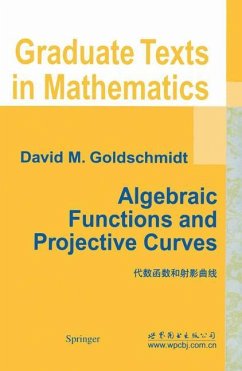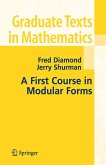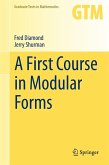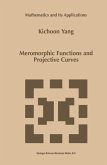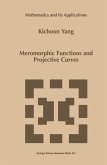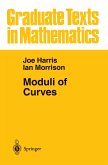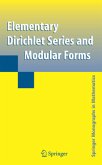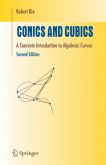This book gives an introduction to algebraic functions and projective curves. It covers a wide range of material by dispensing with the machinery of algebraic geometry and proceeding directly via valuation theory to the main results on function fields. It also develops the theory of singular curves by studying maps to projective space, including topics such as Weierstrass points in characteristic p, and the Gorenstein relations for singularities of plane curves.
This book grew out of a set of notes for a series of lectures I orginally gave at the Center for Communications Research and then at Princeton University. The motivation was to try to understand the basic facts about algebraic curves without the modern prerequisite machinery of algebraic geometry. Of course, one might well ask if this is a good thing to do. There is no clear answer to this question. In short, we are trading off easier access to the facts against a loss of generality and an impaired understanding of some fundamental ideas. Whether or not this is a useful tradeoff is something you will have to decide for yourself. One of my objectives was to make the exposition as self-contained as possible. Given the choice between a reference and a proof, I usually chose the latter. - though I worked out many of these arguments myself, I think I can con?dently predict that few, if any, of them are novel. I also made an effort to cover some topics that seem to have been somewhat neglected in the expository literature.
Hinweis: Dieser Artikel kann nur an eine deutsche Lieferadresse ausgeliefert werden.
This book grew out of a set of notes for a series of lectures I orginally gave at the Center for Communications Research and then at Princeton University. The motivation was to try to understand the basic facts about algebraic curves without the modern prerequisite machinery of algebraic geometry. Of course, one might well ask if this is a good thing to do. There is no clear answer to this question. In short, we are trading off easier access to the facts against a loss of generality and an impaired understanding of some fundamental ideas. Whether or not this is a useful tradeoff is something you will have to decide for yourself. One of my objectives was to make the exposition as self-contained as possible. Given the choice between a reference and a proof, I usually chose the latter. - though I worked out many of these arguments myself, I think I can con?dently predict that few, if any, of them are novel. I also made an effort to cover some topics that seem to have been somewhat neglected in the expository literature.
Hinweis: Dieser Artikel kann nur an eine deutsche Lieferadresse ausgeliefert werden.
From the reviews:
"This is a well-written book, which will quickly give the reader access to the theory of projective algebraic curves. The author manages to convey a very good amount of information on this subject, and there's also a lot of results on function fields. The treatment given to the theory of Weierstrass points, in which the ground field may have any characteristic, will certainly be remembered by the reader, even after he/she has studied the subject with the machinery offered by the scheme language. It is the opinion of this reviewer that this book is a fine contribution to a first study of algebraic functions and projective curves." -- MATHEMATICAL REVIEWS
"This is a very nice algebraic introduction to the theory of algebraic curves (no geometry) with full, clear and simple proofs. It should be very useful for workers in coding theory." (Edoardo Ballico, Zentralblatt MATH, Vol. 1034, 2004)
"The author treats some topics not often found elsewhere like Tates theory of residues, inseparable residue field extensions, a proof of the Riemann hypothesis for finite fields etc. Since the book is rather self-contained - even an appendix on field theory is provided - it can be recommended even for non-specialists interested in this classical topic." (G. Kowol, Monatshefte für Mathematik, Vol. 143 (2), 2004)
"This book provides a self-contained exposition of the theory of algebraic curves without requiring any of the prerequisites of modern algebraic geometry. The self-contained treatment makes this important and mathematically central subject accessible to non specialists. At the same time, specialists in the field may be interested to discover several unusual topics." (L'ENSEIGNEMENT MATHEMATIQUE, Vol. 49 (1-2), 2003)
"Goldschmidt ... brings readers, in a minimal number of pages, from first principles to a major landmark of 20th-century mathematics (which falls outside of Riemann surface theory!), namely, Weil's Riemannhypothesis for curves over finite fields. An excellent stepping stone either to algebraic number theory or to abstract algebraic geometry." (D.V. Feldman, CHOICE, July 2003)
"The powerful interaction between algebra and geometry ... led to an unprecedented development of many fields in mathematics, and in particular of the one presently called algebraic geometry. ... This is a well-written book, which will quickly give the reader access to the theory of projective algebraic curves. The author manages to convey a very good amount of information on this subject ... . this book is a fine contribution to a first study of algebraic functions and projective curves." (Cicero Fernandes de Carvalho, Mathematical Reviews, 2003 j)
"This is a well-written book, which will quickly give the reader access to the theory of projective algebraic curves. The author manages to convey a very good amount of information on this subject, and there's also a lot of results on function fields. The treatment given to the theory of Weierstrass points, in which the ground field may have any characteristic, will certainly be remembered by the reader, even after he/she has studied the subject with the machinery offered by the scheme language. It is the opinion of this reviewer that this book is a fine contribution to a first study of algebraic functions and projective curves." -- MATHEMATICAL REVIEWS
"This is a very nice algebraic introduction to the theory of algebraic curves (no geometry) with full, clear and simple proofs. It should be very useful for workers in coding theory." (Edoardo Ballico, Zentralblatt MATH, Vol. 1034, 2004)
"The author treats some topics not often found elsewhere like Tates theory of residues, inseparable residue field extensions, a proof of the Riemann hypothesis for finite fields etc. Since the book is rather self-contained - even an appendix on field theory is provided - it can be recommended even for non-specialists interested in this classical topic." (G. Kowol, Monatshefte für Mathematik, Vol. 143 (2), 2004)
"This book provides a self-contained exposition of the theory of algebraic curves without requiring any of the prerequisites of modern algebraic geometry. The self-contained treatment makes this important and mathematically central subject accessible to non specialists. At the same time, specialists in the field may be interested to discover several unusual topics." (L'ENSEIGNEMENT MATHEMATIQUE, Vol. 49 (1-2), 2003)
"Goldschmidt ... brings readers, in a minimal number of pages, from first principles to a major landmark of 20th-century mathematics (which falls outside of Riemann surface theory!), namely, Weil's Riemannhypothesis for curves over finite fields. An excellent stepping stone either to algebraic number theory or to abstract algebraic geometry." (D.V. Feldman, CHOICE, July 2003)
"The powerful interaction between algebra and geometry ... led to an unprecedented development of many fields in mathematics, and in particular of the one presently called algebraic geometry. ... This is a well-written book, which will quickly give the reader access to the theory of projective algebraic curves. The author manages to convey a very good amount of information on this subject ... . this book is a fine contribution to a first study of algebraic functions and projective curves." (Cicero Fernandes de Carvalho, Mathematical Reviews, 2003 j)

